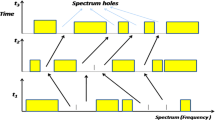Abstract
Cognitive radios have demonstrated its ability in improving spectrum efficiency by accessing licensed spectrum bands opportunistically. Along with the popularity of mobile broadband devices in future mobile communications, research for cognitive radios with mobility will be paid more and more attentions. In this paper, a multi-channel cognitive radio network with mobile secondary users is investigated. Based on the reality that the primary licensed channels have different available states on spatial and temporal dimensions for secondary users, we analyze the spatial-temporal spectrum utilization rate and derive the network throughput of secondary users combined with successful probability of wireless transmission. Finally, through maximizing the throughput we obtain the optimal spectrum access strategy. Numerical results show the effect of the system parameters on the proposed strategy and verify our proposed strategy outperforms other strategies such as equiprobable, inverse proportional and random access strategies.






Similar content being viewed by others
References
Haykin, S. (2005). Cognitive radio: Brain-empowered wireless communications. IEEE Journal on Selected Areas in Communications, 23, 201–220.
Song, M., Xin, C., Zhao, Y., & Cheng, X. (2012). Dynamic spectrum access: From cognitive radio to network radio. IEEE Wireless Communications, 19, 23–29.
Xuemin, H., Jing, W., Cheng-Xiang, W., & Jianghong, S. (2014). Cognitive radio in 5G: A perspective on energy-spectral efficiency trade-off. IEEE Communications Magazine, 52, 46–53.
Bao, X., Martins, P., Song, T., & Shen, L. (2010). Stable Throughput analysis of multi-user cognitive cooperative systems. In IEEE Global Communications Conference, pp. 1–5.
Banaei, A., & Georghiades, C.N. (2009). Throughput analysis of a randomized sensing scheme in cell-based ad-hoc cognitive networks. In IEEE International Conference on Communications, pp. 1–6.
Yang, Q., Xiaoxiong, Z., Yuanyuan, Y., Yanlin, L., & Li, L. (2014). Joint channel assignment and opportunistic routing for maximizing throughput in cognitive radio networks. In IEEE Global Communications Conference, pp. 4592–4597.
Jun, Z., Li, Y., & Peng, Y. (2014). Throughput analysis of cognitive radio networks via stochastic network calculus. In Sixth International Conference on Wireless Communications and Signal Processing, pp. 1–6.
Shuang, L., Ekici, E., & Shroff, N. (2015). Throughput-optimal queue length based CSMA/CA algorithm for cognitive radio networks. IEEE Transactions on Mobile Computing, 14, 1098–1108.
Min, A.W., Kim, K.-H., Pal Singh, J., & Shin, K.G. (2011). Opportunistic spectrum access for mobile cognitive radios. In IEEE INFOCOM, pp. 2993–3001.
Ross, S. M. (1983). Stochastic processes. New York: Wiley.
Wenye, W., & Ming, Z. (2008). Joint effects of radio channels and node mobility on link dynamics in wireless networks. In IEEE INFOCOM, pp. 1606–1614.
Cho, H., & Hwang, G. (2013). An optimized random channel access policy in cognitive radio networks under packet collision requirement for primary users. IEEE Transactions on Wireless Communications, 12, 6382–6391.
ElSawy, H., Hossain, E., & Haenggi, M. (2013). Stochastic geometry for modeling, analysis, and design of multi-tier and cognitive cellular wireless networks: A survey. IEEE Communications Surveys and Tutorials, 15, 996–1019.
Dafei, S., Tiecheng, S., Ming, W., Jing, H., Jie, G., & Bin, G. (2013). Optimal sensing time of soft decision cooperative spectrum sensing in cognitive radio networks. In IEEE Wireless Communications and Networking Conference, pp. 4124–4128.
Hu, J., Yang, L.-L., & Hanzo, L. (2013). Maximum average service rate and optimal queue scheduling of delay-constrained hybrid cognitive radio in nakagami fading channels. IEEE Transactions on Vehicular Technology, 62, 2220–2229.
Zhang, G., Yu, L., & Wu, T. (2005). Global optimal algorithm for nonlinear programming problems subjected to linear constraints. Control Theory and Applications, 22, 1–8.
Acknowledgments
This work is supported by the National Natural Science Foundation of China (Nos. 61271207, 61372104, 61502210) and Natural Science Foundation of Jiangsu Province of China (No. BK20160294).
Author information
Authors and Affiliations
Corresponding author
Rights and permissions
About this article
Cite this article
Zhang, L., Song, T., Hu, J. et al. Spatial-Temporal Spectrum Access Analysis for Multi-Channel Mobile Cognitive Radio Networks. Wireless Pers Commun 94, 2819–2831 (2017). https://doi.org/10.1007/s11277-016-3720-z
Published:
Issue Date:
DOI: https://doi.org/10.1007/s11277-016-3720-z




